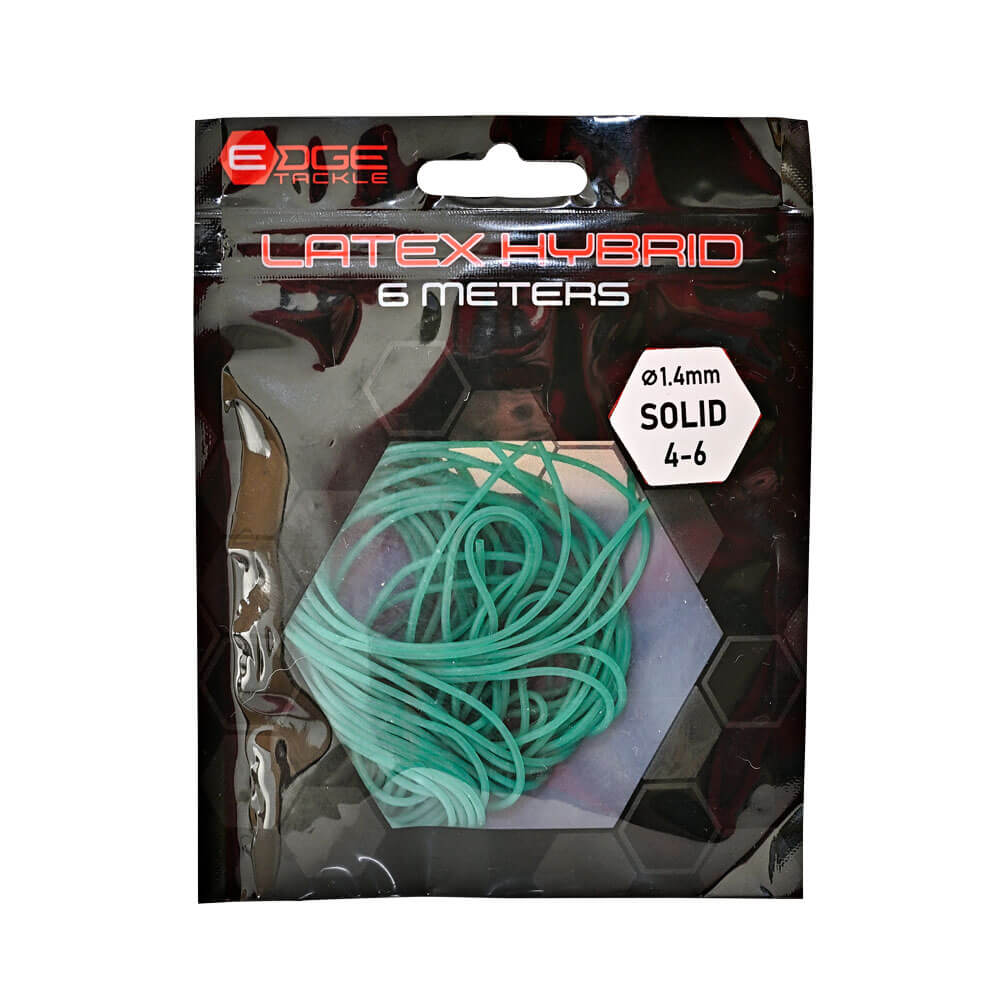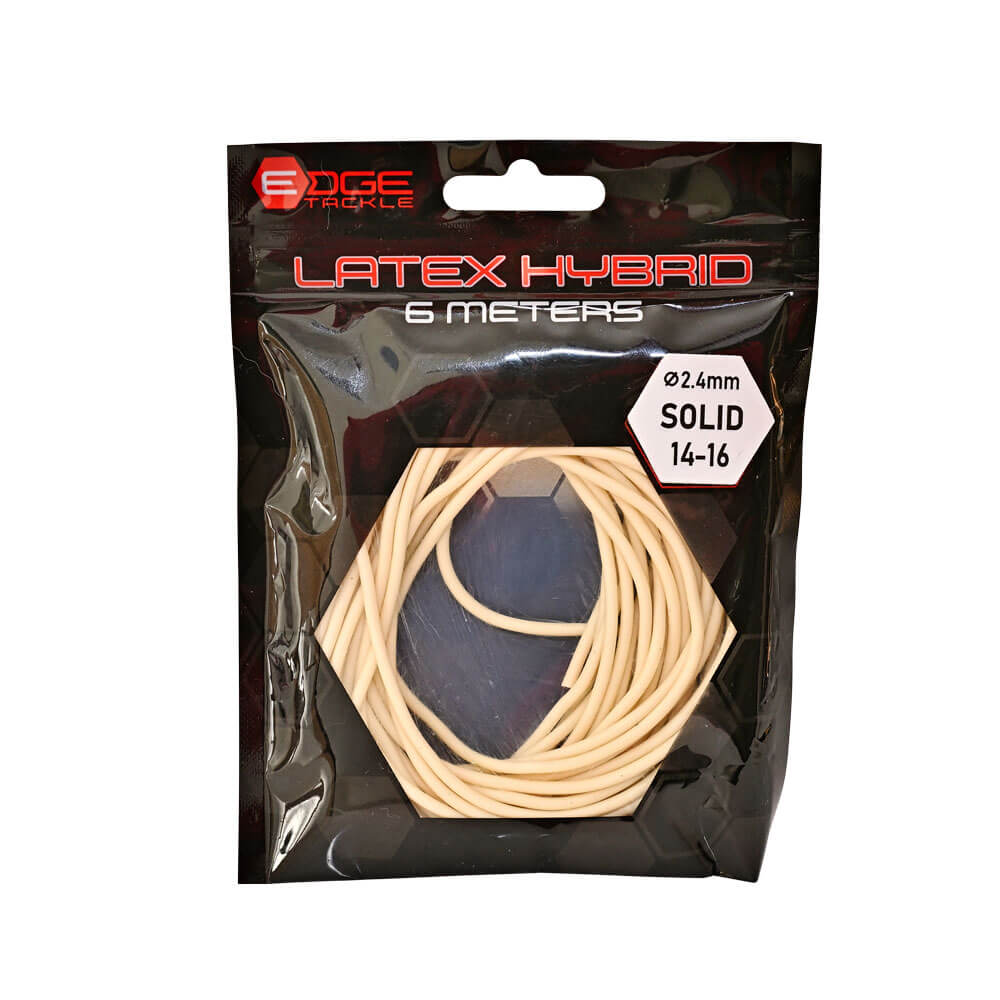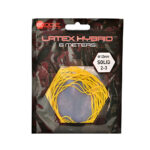Latex Hybrid Solid
£6.99
- Solid elastic with a round profile.
- Medium to High stretch ratio – approximately up to 650%.
- Smooth surface finish aids elongation and recovery.
- Solid colours not colour coated.
- Not as fierce as more traditional solids.
- Builds up its power progressively.
- Knots exceptionally securely.
- Packed in resealable bags to protect the elastic.
- 6m lengths for economy when multiple kits are needed.
Our Elastics – Why is it called a Hybrid ???
It can be very confusing currently because there are so many elastic ‘types’ available. No matter if solid or hollow they are not all the same and performance can vary wildly.
However, all do a job. They all work.
Decades ago, in the UK through the 70’s and 80’s, choices of elastics were few and there were only solids. As far as we can remember most, if not all, were white (some may have been a pale grey, maybe some black) and sizes were few. Some hollow aluminium Crooks came pre-fitted with such elastic. Many will remember Zim and, again if our memory is right, No 8 was the thickest we used. Different solids came, bigger sizes came and also colours (some external coloured with white cores and thereafter solid colours). Then fluorescents. Then, hollows (simply think thin catapult elastic). And those hollows stretched far more than the solids of the time. So it became common thinking that hollows stretched far more than solids. Because, at that time with what was available, they did. But it wasn’t because they were hollow it was simply the latex mix or compound and/or processing. Basically, we were not comparing Apples with Apples.
Fast forward to the current day and now we can have solid latex threads that stetch far more than the solids we used many years ago and same or similar to the hollows we used and do use. The generic term used seems to be Hybrid. A solid latex thread which stretches extensively like a hollow.
As mentioned in the beginning not all solids and not all hollows are the same. Some will stretch more or less than others. And, if it can confuse things more, not all of the same sizes, in the same range in the same brand will necessarily behave the same. Different batches processed at different times can be different and the pigments used can make the finished product behave radically differently. So, and just for example, it could be that red can stretch more than blue, blue can have more resistance (power) than yellow of same physical size etc etc. But as we have said they all do a job and they all work. It’s not that one is right and another is wrong. They are just different.
As a guide, our elastics have a stretch factor, on average of around +550%. That means a 2m length could stretch to 13m. Or to put it another way the 2m length could stretch to 650% of its original length. It just depends which way you want to look at it. Some we have tested stretch up to an EXTRA 766% or to 866% of it’s original !!! That means 2m stretching to over 17m. By comparison most of the solids we used years & decades ago were in the region of +350% to +400%. So that same 2m could become 9m or 10m only (some only got to 7m – they bottomed out so quickly and were very fierce despite not being the thickest) so it’s no wonder hollows of the time were considered very stretchy!
Because some stretch more or less than others some can ‘power-up’ later or sooner as the resistance builds. Those which stretch further still ‘power-up’ but just stretch farther before they do and can reach the same or similar resistance anyway. Also, the initial length of elastic (and the tension it is set under) has a big impact on how far they can stretch and that power. Obviously the longer the starting length the more it can stretch in terms of actual distance. Shorter lengths will create more resistance sooner and bottom our sooner. So a 2m length might stretch to 13m whereas a 1m of same might stretch to 6.5m etc. That 13m means that you have 11m out of the end of your pole. But this is, pretty much, in this example the maximum and there will be a lot of resistance at that extreme.
With ours we have tried to be very careful not to produce an elastic which has ‘miles’ and ‘miles’ of stretch like some available (think 866%+) and not one which has a low stretch (again think something like 400%) which just behaves harshly risking hook pulls and broken hooklengths etc. Essentially one that stretches enough to provide a an initial cushion but does not stretch so far that it doesn’t create enough resistance fast enough and having no control at all of the fish. Of course, all of this still depends on choosing the right size/diameter and setting up the correct length & tension in the first place.
What does 6-8 or 10 – 12 mean ?? Well we tested, measured and calibrated many elastics. It took some time but was simple enough to do checking the force needed to stretch a set length of elastic 100%, 200%, 300% etc etc. The grading we settled on, like anyone’s really, is just a guide to the strength or power or resistance of the elastic. So 6 – 8 is roughly equivalent to a No 6 or No 8 in solids we were/are used to using depending on make etc. We grade our elastics both ways and give a guide like 6 – 8 & 1.6mm simply to help compare one to another within our range. There are so many elastics out there and they are not all the same and manufacturing tolerances mean that it is not really possible to give an exact grading. Hence the dual rating. Hollows are especially difficult as there is a tolerance on both the O/D (thickness) and the I/D (hole).
So which should you use – solid or hollow ?? That’s a difficult one to answer. There are many who use solids, always have and always will. Same goes for some people with hollows.
When you compare ‘power’ for ‘power’ solid will allow you to use a smaller PTFE bush, so less cutting back and more carbon left to fish with. It doesn’t flatten and create resistance like hollow and some makes can be more difficult to knot. This can often be made easier by cleaning the last few cm before tying.
Hollows are thicker, obviously due to the core, so need bigger PFTE’s and the pole cutting back more and so less carbon to fish with. They actually knot much better and more securely as the elastic collapses and ‘bites’ into itself. The flattening can be a big advantage in certain situations for big fish as well as very small fish (e.g when swinging to hand the elastic will flatten on the PTFE and stop the elastic from streeeeetching and streeeetching whereas solids can just keep going and you end up pushing the pole kit higher and higher). A good tip is to wet the knot when pulling it tight as hollows bed down almost completely and you don’t want to create friction damaging the elastic.
It’s really horses for courses.
To Lube or not to lube – that is the question. Many, if not most, don’t seem to use anything other than the water from the venue. It works for them so why try to fix something that’s not broken ? Let’s face it, if Mr Angry 6lb carp is running around your elastic is going to stretch. But a good quality lubricant does more than just help stretch & recovery. A good coating can help to slow down the rotting & perishing process. After all latex will perish and it is going to rot. You cannot stop it – only slow the process down. So think of a good quality lubricant as Suntan Lotion for elastic !!! Just shielding or hiding latex from sunlight/artificial light has a massive impact on the rate at which it rots. Many is the time when a display catapult where the exposed elastic is folded over and hanging down has rotted and needs changing. However, flip the catapult over and the part of the elastic which was underneath (the very same length, just the opposite side) can be virtually perfect. It wasn’t exposed to light in the same way or anywhere near as much. Interestingly, the rotting always takes place first at any point where the elastic is stretched over something or tied (so in the case of catapults the pins of the frame or connection at the pouch). So elastic connectors and puller beads are places to monitor and especially as they will see most sunlight.
Our elastics are in 6m lengths and supplied in resealable bags. So if you cut off some to elasticate one kit and keep the rest in a sealed bag away from light ready for the next elastic change. That way it will last longer. Also 6m gives many permutations for kit lengths. 4 kits x 1.5m, 3 kits x 2m, 2 kits x 3m. So in terms of value for money it is excellent.
Related products























